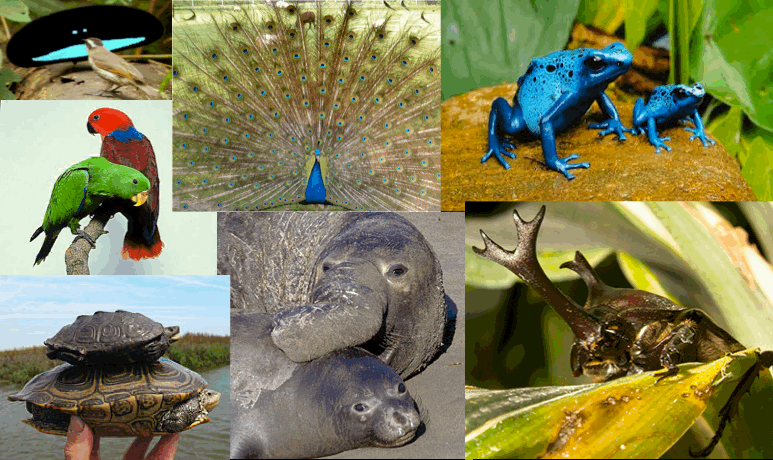
Sexual selection
n., plural: sexual selections
[ˈsɛkʃuəl səˈlɛkʃən]
Definition: A form of natural selection wherein male or female is attracted by certain characteristics, behaviour, etc., in the opposite sex
Table of Contents
What is Sexual Selection?
The definition of sexual selection is very interesting in biological terms. The sexual selection idea proposes that animals with distinctive physical characteristics, such as dramatic color, enhanced size, or eye-catching adornments, may have an easier time acquiring mates. Natural selection holds that such improvements in mate-finding opportunities offset the risks associated with the animal’s greater degree of environmental visibility. Sexual and natural selection are very similar entities but it is easy to distinguish sexual selection from natural selection.
Intersexual selection is the process by which members of one biological sex choose partners from the other sex to mate with. Sexual selection is the process by which individuals compete with one another for access to mates from the other sex (intrasexual selection).
Because of these two types of selection, some people in a population are more likely to have fertilization success and successfully reproduce than others, for example, because they are more attractive or choose to have children with attractive partners.
Frequent mating and having exclusive access to one or more reproductive females are advantageous to successful males. By choosing and mating with the top guys, females can maximize the return on the energy they invest in reproduction.
By combining knowledge from genomes, developmental biology, natural population studies, and experimental investigations, evolutionary biology aims to explain how the astounding diversity of life on our planet developed.
Sexual selection plays a key role in how evolutionary biology works as sexual selection occurs as a part of how organisms evolve. This is the same for behavioral ecology and animal behavior.

Males contribute to female behavior and female reproduction because mate preferences are often based on what the other sex does and provides. These affect mating success and affect reproductive success because male fitness and female fitness – that is that their reproductive success – as well as male and female mates, depend on each other for producing offspring.
When organisms do not undergo sexual selection, it often leads to few or no offspring being able to survive in future years to come. This is why sexual selection has direct benefits to the genetic variation and genetic correlation of organisms as they assist the genetic makeup in becoming the best possible option for the survival of the next generation. This increases sexual reproduction with animals that have higher genetic quality, making for higher mating success with preferred males and females.
The role of sexual selection in sculpting phenotypes, from fascinating and distinctive displays to cryptic characteristics whose function is only revealed after diligent investigation, has long been recognized. Finding a common definition of the word “sexual selection” has been challenging, despite decades of research.
Here, we investigate why it is so challenging to come up with a common concept of sexual selection. We focus on where the boundary between sexual selection and other kinds of selection lies, despite the fact that some academics have disagreed over whether sexual selection should be considered a component of natural selection.
We emphasize finding the “grey zones” of sexual selection by illuminating instances in which the phrase “sexual selection” application would be seen as contentious or ambiguous. We think that explaining why sexual selection is so hard to describe is a crucial first step toward greater clarity and, ideally, toward arriving at a consensus definition.
We contend that a more nuanced viewpoint could be required, especially one that clarifies the purpose behind the phrase “sexual selection” in cases of such behavior or whether such situations fall into a grey area.
Sexual selection is a type of natural selection where, in accordance with Darwin’s theory, the male or female is drawn to particular traits, such as form, color, or behavior, in the other sex; as a result, changes in a particular sort are made to the species.
Watch this vid about sexual selection:
Importance of Defining Sexual Selection
The fitness of one sex depends on the opposite sex, according to all current definitions of sexual selection. This brings up a potential distinction between sexual selection and other kinds of selection.
Sexual selection is inescapably frequency-dependent—that is, it will change in strength or even direction depending on the frequency of other genotypes in the population—because it involves interactions between various individuals that depend on their phenotypes or genotypes.
Fecundity selection, on the other hand, is typically a preferred trait unique to the phenotype or genotype of the targeted individual (though it can be affected by social interactions or population composition, e.g. via competition for resources).
The development of mating preferences and features can be influenced by frequency dependence, illustrating one way that sexual selection may have different evolutionary expectations than fecundity selection.
Researchers use sexual selection to explain the existence of complex characteristics as well as a variety of other evolutionary outcomes and occurrences. According to certain theories, sexual selection promotes adaptation and prevents extinction (in other cases, it raises the danger of extinction by removing harmful genes) (by decreasing population mean fitness).
Sexual selection through condition dependency, in which females choose males that are in the best condition, may also aid in the successful colonization of a new habitat by niche expansion. Last but not least, a lot of research has been done to determine whether sexual selection speeds up or slows down the processes of speciation and diversification.
Regarding the part that sexual selection plays in these processes, we would like to be able to make generalizations. Without a shared understanding and diagnostic definition of what we mean by “sexual selection”, this effort is made considerably more difficult.
The Mechanisms of Sexual Selection
All living species, according to Charles Darwin’s theory, descended from a common ancestor. Natural selection, which holds that creatures more adapted to their environment would profit from higher rates of survival than those less well-equipped to do so, was the main mechanism he postulated to explain this phenomenon.
Nonetheless, he observed that there were numerous instances of complex sexual features that appeared to be non-adaptive and would unquestionably not help their bearers survive. He proposed that these characteristics might evolve if they are sexually chosen, or if they promote the reproductive success of the individual, even at the expense of their survival (Darwin 1871).
Darwin recognized that the battle between males to access females is what drives sexual selection. He identified two types of sexual selection: intersexual selection, in which members of one sex (often females) favor members of the other sex, and intrasexual selection, in which members of the same sex – which is typically the males – as they compete amongst themselves for acquiring mates.
Soon after Darwin’s publication, scientists were quick to embrace the sexual selection theory that heavy features evolved to help males compete during violent encounters. However, the notion of female mate choice was mocked, and it wasn’t until over 80 years later that it was carefully reconsidered (Cronin 1991). Since then, there has been a significant advancement in our knowledge of sexual selection.
Modern Theory
This is a genetic theory about sexual selection acts and how they impact the reproductive competition and genetic makeup of different species. These continue to do immense research as this topic is ever-growing.
Reproductive success
The quantity of offspring produced and the fitness of those offspring are used to determine an organism’s reproductive success. A tendency toward homogamy or assortative mating success is caused by sexual preference.
The general characteristics of sexual discrimination seem to be (1) the acceptance of one mate precludes the effective acceptance of alternative mates, and (2) the rejection of an offer is followed by other offers, either definitely or at such a high chance that the risk of non-occurrence is smaller than the advantage gained by choosing a mate.
According to Bateman’s principle, the sex that invests the most in procreation turns into a limiting resource that the opposite sex competes for. This is demonstrated by the greater nutritional investment of an egg in a zygote and the restricted female reproductive success.
For instance, in humans, a woman can only give birth once every ten months while a man can become a father multiple times in the same time frame. Researchers now question if Bateman’s findings were accurate.
Honest signaling
According to the handicap principle proposed by Amotz Zahavi, Russell Lande, and W. D. Hamilton, a female will interpret a male’s ability to survive until and through sexual maturity despite the presence of features that appear to be unfit for reproduction.
Such limitations could demonstrate that he is disease-free or disease-resistant, or that he has higher physical power or speed, which he uses to deal with the difficulties caused by the exaggerated attribute.
In response to Zahavi’s findings, the topic was reexamined and various new ideas were developed. The “Bright Male” concept, first proposed by Hamilton and Marlene Zuk in 1984, postulated that male elaborations might act as a measure of health by exaggerating the symptoms of disease and deficiency.
Male intrasexual competition
When two males of the same species contend with one another for the right to mate with a female, this is known as male-male competition. Size, sex ratio, social context, and sexually dimorphic traits (otherwise known as sexual dimorphism) may all have an impact on how male-to-male competition affects a male’s ability to reproduce and a female’s ability to decide to mate.
Male-male clashes are typically won by larger males. Men take numerous risks in these battles, thus the resource’s worth needs to be high enough to make those risks acceptable. Male behavior is further influenced by the winner and loser effects. Competition between males may also make it more difficult for females to choose the best partners, which reduces the likelihood of fertile reproduction.

Multiple models
The discipline has expanded more subsequently to encompass additional research fields, not all of which adhere to Darwin’s notion of sexual selection. A “bewildering” variety of models make various attempts to connect sexual selection to issues like sex ratios, parental care, parental investment in sexually appealing offspring, sexual conflict, and the “most-debated effect”, which is mate choice.
These models also attempt to connect sexual selection to fundamental issues like anisogamy and parental roles. Because “compensatory traits” have evolved in tandem with the sexually selected traits, elaborate attributes that would seem expensive, like the tail of the Montezuma swordfish (Xiphophorus montezumae) do not always have an energetics cost, neither does it have performance nor survival cost.
Toolkit of natural selection
Natural and sexual selection sometimes go hand in hand. The survival value of traits like feathers early in their evolution may be explained by sexual selection. Protarchaeopteryx, one of the oldest proto-birds, possessed well-developed feathers but was incapable of flight.
The forelimb feather displays during proto-bird courting may have acted as insulation, aiding females in the incubation of their eggs, although the shift to flight may have been quite simple.
This has been hypothesized in relation to the enormous antlers of the Irish elk (Megaloceros giganteus), which went extinct in Pleistocene Europe, sexual selection may occasionally produce such traits that contribute to the extinction of a species. It might also have the reverse effect, causing species divergence and, occasionally, complex genitalia alterations that result in the emergence of new species.
In different taxa
There is widespread sexual selection in eukaryotes, including in plants, fungi, and mammals. Since Darwin’s groundbreaking observations on people, it has been extensively explored among insects, spiders, amphibians, scaled reptiles, birds, and mammals, showing many unique behaviors and physical adaptations.
In mammals
Charles Darwin’s discoveries about sexual selection in humans and other mammals, which consists of male-male competition and mate choice that shape the development of future phenotypes in a population for a specific sexually reproducing species, sparked the study of sexual selection in mammals.
Darwin hypothesized that sexual selection in humans is the cause of heritable features like beards, hairlessness, and steatopygia in various human populations. Due to sexual dimorphism (morphological traits) in humans, females choose their partners based on characteristics such as voice tone, facial features, muscularity, and height.
Extreme sexual dimorphism, where males can be up to six times bigger than females, and male competition for dominance among elephant seals are just two examples of sexual selection in mammals.
Successful males may try to mate with a harem male’s females if the dominant male is not paying attention. Dominant males develop enormous harems of several dozen females. The harem male is compelled to defend his territory constantly as a result, going up to three months without eating.
As in the highly social meerkats, where a huge female is dominant within a pack and female-female competition is prevalent, sex-role reversal is also seen in mammals. The subordinate females care for the young in an altruistic manner while the dominant female bears the majority of the offspring.
In arthropods
In a large variety of spider species, sexual selection happens both before and after copulation. Sperm competition and mysterious female choice (or female preference) are both aspects of post-copulatory sexual selection.
When multiple males or more than one male compete for mating opportunities or mating preferences to fertilize the female’s egg, this is known as sperm competition. The expulsion of a male’s sperm during or after copulation is known as cryptic female choice.
Insects engage in a variety of sexual selection processes. Insect male parental care can be found in belostomatid water bugs, where the male, after fertilizing the eggs, permits the female to glue her eggs to his back.
Female insects, like bees, frequently give parental care. He raises them until 2-4 weeks later when the nymphs hatch. The big eggs increase the likelihood of predation on the male and decrease his ability to fertilize other females and catch prey.
In the case of the firefly (Lampyrid beetles), males fly at night while emitting a particular pattern of light flashes that receptive females respond to by perching. The flashes’ color and temporal variety aid in their ability to draw in females.
In amphibians and reptiles
Male-male competition occurs throughout the annual breeding seasons of many amphibians. Males gather in great numbers first near the water’s edge and use a variety of vocalizations to entice females. Frog ladies choose their partners in part depending on the depth of the croak, with the fittest males having the deepest croaks and the best territories.

As a result, there is sexual dimorphism, with 90% of species having larger females than males and males competing for female attention. A female in some species, like P. bibronii, can mate with several males at once. Snakes employ a variety of strategies to find partners.
Topping, a behavior displayed by most viperids in which one male would wrap around the vertically elevated fore body of its opponent and force it lower, is a form of a ritual battle between males for the females they wish to mate with. As the snakes are entangled, neck biting is frequent.
In birds
Many different types of sexual selection and a vast range of mating behaviors have evolved in birds. They include intrasexual rivalry (both rival males and females), in which members of the more numerous sex struggle with one another for the right to mate, and intersexual selection (female choice).
Several species, most notably the birds of paradise, are sexually dimorphic; the variations in size and coloring are energetically expensive traits that indicate competitive breeding. Conflicts between a person’s signaling adaptations and fitness ensure that sexually selected ornaments like feather color and courtship behavior are honest characteristics.
To make sure that only high-quality individuals may exhibit these extreme sexual decorations and behaviors, signals must be expensive. Females of several bird species prefer the males with the brightest plumage.
Many different bird species employ mating calls, with the females favoring the males who sing complex and varied songs in terms of amplitude, structure, and frequency. Bigger men sing more deeply and have better male mating success.
In plants and fungi
Flowering plants include a wide range of secondary sexual characters, (secondary sexual characteristics) or secondary sexual traits that are vulnerable to sexual selection. These particular traits include sexual dimorphisms, nectar production, floral structure, and inflorescences, as well as floral symmetry if pollinators visit flowers assortatively by the degree of symmetry.
Fungi frequently reproduce asexually, but they also seem to use sexual selection. The Basidiomycetes’ sex ratio is biased in favor of men, suggesting that sexual selection has taken place there. Yeasts are fungi that compete with other fungi’s males to produce fertile eggs.
Female gametes and conidia use pheromone communication, which implies male preference in these circumstances. The significantly faster evolution of female-biased good genes in fungi suggests that female-female rivalry may possibly take place. The male gametes do not have much of an impact in this case.
Note it!
Current assertions that the sexual selection theory is fundamentally faulty are simply false and overlook a vast amount of data that serves as a rock-solid foundation for support for this important organic evolution mechanism. In fact, it is in great part because of this strong basis that contemporary research is now focusing on answering more complicated evolutionary problems rather than just determining whether or not sexual selection occurs.
Take the Sexual Selection – Biology Quiz!
Further Reading
- Biology Tutorial: Darwin and Natural Selection
- Biology Tutorial: The Evolutionary Development of Multicellular Organisms
- On Mate Selection Evolution: Are intelligent males more attractive?
- A Look Into Natural Selection and its Mechanisms
- Molecular Basis of Temperature-Dependent Gender of Red-Eared Slider Turtle
References
- Bateman, A. J. (1948). Intra-sexual selection in Drosophila. Heredity, 2(Pt. 3), 349–368. https://doi.org/10.1038/hdy.1948.21
- Cayuela, H., Lengagne, T., Kaufmann, B., Joly, P., & Léna, J.-P. (2016). Larval competition risk shapes male–male competition and mating behavior in an anuran. Behavioral Ecology, 27(6), 1726–1733. https://doi.org/10.1093/beheco/arw100
- Eberhard, W. G. (2009). Postcopulatory sexual selection: Darwin’s omission and its consequences. Proceedings of the National Academy of Sciences of the United States of America, 106 Suppl 1(Suppl 1), 10025–10032. https://doi.org/10.1073/pnas.0901217106
- Eberhard, W. G. (2010). Evolution of genitalia: Theories, evidence, and new directions. Genetica, 138(1), 5–18. https://doi.org/10.1007/s10709-009-9358-y
Evolutionary Biology. (n.d.). Retrieved March 11, 2023, from https://www.biology.ox.ac.uk/evolutionary-biology - Feinberg, D. R., Jones, B. C., Law Smith, M. J., Moore, F. R., DeBruine, L. M., Cornwell, R. E., Hillier, S. G., & Perrett, D. I. (2006). Menstrual cycle, trait estrogen level, and masculinity preferences in the human voice. Hormones and Behavior, 49(2), 215–222. https://doi.org/10.1016/j.yhbeh.2005.07.004
- Gilbert, J. D. J., & Manica, A. (2015). The evolution of parental care in insects: A test of current hypotheses. Evolution; International Journal of Organic Evolution, 69(5), 1255–1270. https://doi.org/10.1111/evo.12656
- Hosken, D. J., & House, C. M. (2011). Sexual selection. Current Biology, 21(2), R62–R65. https://doi.org/10.1016/j.cub.2010.11.053
- Luo, Z., Li, C., Wang, H., Shen, H., Zhao, M., Gu, Q., Liao, C., Gu, Z., & Wu, H. (2016). Male-male competition drives sexual selection and group spawning in the Omei treefrog, Rhacophorus omeimontis. Behavioral Ecology and Sociobiology, 70(4), 593–605. https://doi.org/10.1007/s00265-016-2078-2
- Nieuwenhuis, B. P. S., & Aanen, D. K. (2012). Sexual selection in fungi. Journal of Evolutionary Biology, 25(12), 2397–2411. https://doi.org/10.1111/jeb.12017
- Procter, D. S., Moore, A. J., & Miller, C. W. (2012). The form of sexual selection arising from male-male competition depends on the presence of females in the social environment. Journal of Evolutionary Biology, 25(5), 803–812. https://doi.org/10.1111/j.1420-9101.2012.02485.x
- Saino, N., Romano, M., Rubolini, D., Teplitsky, C., Ambrosini, R., Caprioli, M., Canova, L., & Wakamatsu, K. (2013). Sexual dimorphism in melanin pigmentation, feather coloration and its heritability in the barn swallow (Hirundo rustica). PloS One, 8(2), e58024. https://doi.org/10.1371/journal.pone.0058024
- Sexual selection | biology | Britannica. (n.d.). Retrieved March 7, 2023, from https://www.britannica.com/science/sexual-selection
- Sexual Selection | Learn Science at Scitable. (n.d.). Retrieved March 7, 2023, from https://www.nature.com/scitable/knowledge/library/sexual-selection-13255240/
- Sexual selection—Understanding Evolution. (2020, August 26). https://evolution.berkeley.edu/evolution-101/mechanisms-the-processes-of-evolution/sexual-selection/
- T.h, C.-B., S.j, H., G, S., A.f, R., N.r, J., N.c, B., L.l, S., & M.b, M. (2006). Intrasexual competition and sexual selection in cooperative mammals. https://doi.org/10.1038/nature05386
- Trait selection in flowering plants: How does sexual selection contribute? – PubMed. (n.d.). Retrieved March 11, 2023, from https://pubmed.ncbi.nlm.nih.gov/21672758/
- Weir, L. K. (2013). Male–male competition and alternative male mating tactics influence female behavior and fertility in Japanese medaka (Oryzias latipes). Behavioral Ecology and Sociobiology, 67(2), 193–203. https://doi.org/10.1007/s00265-012-1438-9
- Whittle, C. A., & Johannesson, H. (2013). Evolutionary dynamics of sex-biased genes in a hermaphrodite fungus. Molecular Biology and Evolution, 30(11), 2435–2446. https://doi.org/10.1093/molbev/mst143
- Zahavi, A. (1975). Mate selection-a selection for a handicap. Journal of Theoretical Biology, 53(1), 205–214. https://doi.org/10.1016/0022-5193(75)90111-3
- Zehavi, A., & Zahavi, A. (1997). The handicap principle: A missing piece of Darwin’s puzzle. Oxford University Press. http://catdir.loc.gov/catdir/enhancements/fy0635/96042374-d.html
©BiologyOnline.com. Content provided and moderated by Biology Online Editors.



